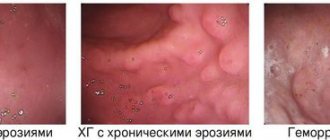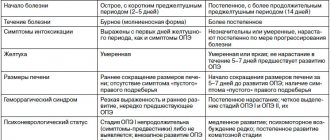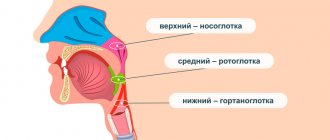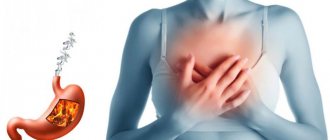Chronic gastritis is a group of recurrent, long-term diseases that are characterized by inflammatory and degenerative changes in the gastric mucosa.
Classification of chronic gastritis according to functional characteristics:
- Gastritis with normal secretion.
- Gastritis with increased secretion (hyperacid).
- Gastritis with insufficiency of secretion (hypoacid).
- Gastritis with lack of secretion (anacidic).
Gastritis, a characteristic feature of which is low acidity, is called hypoacid .
With this type of gastritis, inflammation of the gastric mucosa leads to a decrease in secretory and motor functions. Hypoacid gastritis is manifested by dysfunction of cells that produce hydrochloric acid, which leads to a decrease in acidity levels.
Causes of hypoacid gastritis
The reasons due to which this disease appears can be external and internal.
External ones include:
- abuse of tobacco products and alcoholic beverages;
- improper diet, spicy, fried, fatty, smoked foods;
- abuse of medications with side effects on the gastric mucosa;
- harmful effects of chemicals and radioactive substances;
Internal include:
- gastrointestinal pathologies and disorders of the immune system;
- impaired metabolism, liver, pancreas and thyroid glands;
- various genetic abnormalities in the development of the mucous membrane.
Hypoacid gastritis most often affects adults and males. Children and women are less susceptible to this disease.
Stages of disease development
The disease occurs in four stages:
- Hyperemic. The gastric mucosa becomes reddish and swollen.
- Hypertrophic. There is a thickening of the mucosa with a simultaneous decrease in the production of hydrochloric acid. Changes in tissues and cells (dysplasia) and accumulation of leukocytes in the wall of the organ (metaplasia) are possible.
- Atrophic. With prolonged inflammation, the gastric mucosa becomes thinner, regeneration worsens, epithelial cells die, and are replaced by scar tissue.
- Erosive and/or ulcerative. On the inner surface of the organ, due to the thinning of the mucous membrane, lesions of varying depths form.
Symptoms and signs of the disease
The symptoms of such gastritis are associated with the severity of the disease. At the very beginning, they may not be noticeable at all. But later complaints with hypoacid gastritis are as follows:
- pain in the upper abdomen (sometimes radiating under the ribs on the left side);
- feeling of discomfort (feeling of heaviness, bloating);
- belching “rotten eggs”, metallic taste in the mouth, tongue with a gray coating;
- poor appetite;
- frequent diarrhea or constipation;
- nausea, excessive salivation;
- chronic fatigue, headaches, low performance;
- weight loss, changes in sleep patterns.
During a severe exacerbation, other signs may be added: rapid heartbeat, fainting.
How to diagnose hypoacid gastritis
If you notice similar symptoms, you should consult a specialist in the field of gastroenterology for diagnosis. To determine the clinical picture and make a correct and accurate diagnosis, the doctor usually conducts an examination, finds out complaints and prescribes tests and studies, as a result of which the type of pathology and how affected the gastric mucosa is determined. To determine chronic hypoacid gastritis use:
- visual examination of the stomach using a gastroscope (gastroscopy);
- endoscopic biopsy (taking material for biopsy);
- pH-metry of the acidity of secreted gastric juice;
- blood tests and coprogram.
Having collected a complete picture as a result of instrumental and laboratory studies, the doctor proceeds to drawing up a treatment program.
Diagnostics.
Diagnosis of chronic gastritis is based on identifying complaints, collecting anamnesis, objective examination and conducting laboratory and instrumental examination methods.
The patient is recommended to undergo a clinical blood test, a biochemical blood test - ALT, AST, total bilirubin, amylase, glucose. The gold standard for diagnosis is an FGDS; to diagnose Helicobacter pylori infection, a urease breath test or a stool test for Hp Ag is used.
Additional methods:
- Ultrasound of the abdominal organs;
- with atrophy of the gastric mucosa - determination in the blood: pepsinogen 1, pensinogen 2, gastrin 17;
- determination of antibodies in the blood to gastric parietal cells and intrinsic Castle factor;
- determination of the level of vitamin B12 in the blood.
Hypoacid gastritis: treatment
The treatment of such gastritis is based on an integrated approach using various methods and medications acting in different directions.
- To return the functioning of the digestive system to normal, replacement therapy is used (preparations of natural gastric juice, hydrochloric acid, enzymes).
- Antispasmodics are used to relieve pain.
- If, based on research results, Helicobacter pylori was detected in the body, then antibiotics are prescribed.
- Impaired metabolism during gastritis leads to a lack of nutrients, so vitamin complexes containing B vitamins and folic acid are prescribed.
- Probiotics are used to restore intestinal flora.
Medicines for hypoacid gastritis should be used strictly as prescribed by the doctor, since deviation from the regimen may disrupt the course of treatment. An important factor during treatment is diet. In this case, the patient is assigned to table No. 2, where rough and indigestible food, very hot and cold dishes are excluded from the diet. In addition, if the secretion of hydrochloric acid decreases, milk consumption should be reduced, replacing it with fermented milk products. Portions should be small, but 6 times a day. As an auxiliary treatment, traditional medicine is possible, which is also best agreed upon with the treating specialist. The most commonly used are decoctions of rose hips, blueberries, and mixtures of aloe and honey.
Digestive insufficiency and its correction from the position of a gastroenterologist in Korolev
O.I.
Kostyukevich Digestion is a set of processes that ensure the processing and transformation of food products into simple chemical compounds that can be absorbed by the cells of the body. This process ensures the replenishment of energy and plastic resources, and therefore is necessary for the life of the body. Digestion is a complex multi-stage process: Stage 1: oral Stage 2: gastric Stage 3: in the duodenum Stage 4: in the small intestine Stage 5: in the large intestine Any disturbances can lead to serious consequences for the body. In the oral cavity, primary hydrolysis of carbohydrates occurs under the action of amylase and maltase in saliva. Disturbances in the synthesis of salivary enzymes will not have such pronounced consequences as with pancreatic insufficiency. However, the lack of pancreatic amylase can to some extent be compensated for by salivary amylase. This explains such a clinical symptom in patients with chronic pancreatitis as hypersalivation. Mechanical and chemical processing of food occurs in the stomach. Mechanical is provided by the motor activity of the stomach, chemical is carried out by enzymes of gastric juice. The initial hydrolysis of proteins occurs in the stomach. Crushed and chemically processed food masses mixed with gastric juice form liquid or semi-liquid chyme. Digestion in the small intestine. The main processes of digestion and absorption of nutrients occur in the small intestine. The role of its initial section, the duodenum, is especially important. Pancreatic, intestinal juices and bile are involved in the digestion process. With the help of enzymes that make up pancreatic and intestinal juices, hydrolysis of proteins, fats and carbohydrates occurs. The exocrine activity of the pancreas consists of the formation and secretion of 1.5–2.0 liters of pancreatic juice into the duodenum. Pancreatic juice is represented by proteolytic, lipolytic and amylolytic enzymes. Alpha amylase, lipase and nuclease are secreted in an active state; proteases - in the form of proenzymes. Pancreatic alpha-amylase breaks down polysaccharides into oligo-, di- and monosaccharides. Pancreatic lipase, active in the presence of bile salts, acts on lipids, breaking them down into monoglycerides and fatty acids. Intestinal juice is the secretion of glands located in the mucous membrane of the small intestine. An adult produces 2–3 liters of intestinal juice per day. Intestinal juice contains more than 20 enzymes that provide the final stages of digestion of all nutrients. There are 2 main stages of digestion:
- Cavity;
- Parietal (membrane).
Cavity digestion occurs with the help of enzymes entering the cavity of the small intestine (pancreatic juice, bile, intestinal juice). As a result of cavity digestion, large molecular substances (polymers) are hydrolyzed to oligomers. Their further hydrolysis occurs in the area adjacent to the mucous membrane and directly on it. Parietal digestion in a broad sense occurs in the glycocalyx zone and on the surface of microvilli. Glycocalyx adsorbs digestive juice enzymes from the cavity of the small intestine. Hydrolysis products arrive at the apical membranes of enterocytes, into which intestinal enzymes are built in, carrying out their own membrane digestion, as a result of which monomers are formed that can be absorbed. Digestion in the large intestine. The role of the large intestine in the process of digesting food is small, since food is almost completely digested and absorbed in the small intestine, with the exception of plant fiber. In the colon, chyme is concentrated by absorbing water, feces are formed and removed from the intestine. Absorption of electrolytes, water-soluble vitamins, fatty acids, and carbohydrates also occurs here. At each of these stages, changes may occur that lead to disturbances in digestion (maldigestion) and/or absorption of food (malabsorption), which will have inevitable clinical consequences. Digestive insufficiency is a discrepancy between the digestive system’s ability to digest and absorb nutrients and the volume and/or composition of incoming food. Digestive insufficiency accompanies a wide range of diseases of the gastrointestinal tract, and can also occur in a healthy person due to an unbalanced diet or too much food eaten, and therefore is very common in the daily practice of a gastroenterologist. Clinical manifestations of digestive insufficiency are found in 25–41% of the population [1]. The term “dyspepsia” is used to refer to numerous symptoms associated with digestive disorders. Manifestations of dyspeptic syndrome traditionally include [2]:
- Heartburn
- Nausea and vomiting
- Belching
- Unpleasant sensations (discomfort or pain) in the epigastric region
- Flatulence
- Stool disorders.
Symptoms of dyspepsia can be observed both together and separately and accompany almost any disease of the gastrointestinal tract. At the same time, each of them has a different origin and different mechanisms of occurrence, and also requires completely different approaches to treatment, which makes it inappropriate to so broadly combine all symptoms with a single term. Currently, the main pathophysiological mechanisms of digestive insufficiency can be classified as follows: 1. Insufficiency of cavity digestion, the causes of which are:
- Diseases of the pancreas, both hereditary and acquired (chronic pancreatitis, condition after pancreatectomy, pancreatic cancer, cystic fibrosis).
- Secretory insufficiency of the stomach (atrophic gastritis, postgastrectomy syndrome).
- Bile acid deficiency or asynchronism of bile flow into the small intestine during biliary obstruction, hepatitis, cirrhosis, cholelithiasis, after cholecystectomy.
- Inactivation of digestive enzymes in gastroduodenitis, duodenal ulcer, dysbacteriosis of the small intestine.
- Disturbances in the transit of intestinal contents and disturbances in the mixing of enzymes with food chyme in duodenal and gastrostasis, intestinal pseudo-obstruction, irritable bowel syndrome.
2. The second group is associated with dysfunction of parietal digestive enzymes, for example, lactase deficiency. In both the first and second cases, a large amount of undigested nutrients remains in the intestinal cavity, which leads to a disruption in the composition of the internal environment of the intestine, incl. changes in pH, osmotic pressure, chemical composition. These changes lead, on the one hand, to secondary damage to the intestinal mucosa and even greater disruption of the digestive processes, and, on the other hand, to a change in the composition of the intestinal microflora, which aggravates existing disorders. Disorders of parietal digestion develop due to:
- disaccharidase deficiency (congenital and acquired lactase deficiency);
- dystrophic changes or death of enterocytes (celiac enteropathy, sarcoidosis, Crohn's disease, bacterial overgrowth).
Gastrogenic digestive insufficiency develops in hypoacid conditions after gastric resection. As a result, the secretion of gastric juice decreases, and due to insufficient secretin stimulation of the pancreas, pancreatic secretion also decreases. It is important that low gastric secretion also leads to microbial contamination of the small intestine, which, in turn, contributes to the inactivation of digestive enzymes. Gastrogenic digestive insufficiency can be manifested by a feeling of heaviness in the epigastric region, nausea, belching, and vomiting. Pancreatic insufficiency. Despite the variety of causes that cause digestive disorders, the most severe disorders are associated with diseases of the pancreas (PG), since it is the most powerful source of digestive enzymes. Exocrine pancreatic insufficiency is divided into primary and secondary [3]:
- primary pancreatic insufficiency is caused by diseases of the pancreas itself, as a result of which the synthesis of enzymes is reduced;
- with secondary pancreatic insufficiency, the amount of digestive enzymes is sufficient, but their action is not fully realized for one reason or another. Secondary pancreatic insufficiency is divided into hepatogenic (cholegenic), gastrogenic, enterogenic and vascular [4].
In hepatogenic insufficiency, the activation of lipase in the intestinal lumen is impaired due to a reduced amount of bile acids or asynchrony of the flow of bile, pancreatic enzymes and chyme into the duodenum. Gastrogenic pancreatic insufficiency develops due to insufficient secretin stimulation of the pancreas. In addition, reduced gastric secretion is compensated for some time by functional tension of the pancreas, which gradually leads to its depletion. Enterogenous pancreatic insufficiency is mainly associated with bacterial contamination. It is important that in the development of this deficiency, not only damage to the mucous membrane of the small intestine by pathogenic and opportunistic flora, but also endotoxins secreted by this flora is important. Vascular pancreatic insufficiency develops when microcirculation in the intestinal wall is impaired. Pancreatic insufficiency is clinically manifested by increased intestinal motility, increased frequency of stools, polyfecal matter, steatorrhea, flatulence, and changes in appetite. Clinical manifestations of lipase deficiency develop before the decrease in amylase and protease activity. This is due to the earlier development of disturbances in lipase production by the pancreas compared to other enzymes and to the more rapid inactivation of lipase in the intestine.
Correction of digestive insufficiency
The main direction in the treatment of patients with syndromes of impaired digestion and absorption, especially when it is impossible to eliminate the causes of their development, is replacement therapy with enzyme preparations. About 150 years ago, the Dutch doctor D. Flesch used an aqueous extract from the pancreas of calves to treat steatorrhea in a patient with diabetes mellitus, but many aspects of the use of enzyme preparations still remain controversial. Considering the variety of nosological forms and pathogenetic mechanisms associated with digestive disorders, the range of indications for the use of enzyme preparations is quite wide. These indications are divided into several groups [5,9]. I. Diseases of the pancreas: chronic pancreatitis with pain and dyspeptic syndromes, with external and intrasecretory insufficiency; conditions after resection of the pancreas; large cysts, pancreatic tumors; diabetes; congenital hypoplasia (Shwachman, Joganson-Blizzard syndromes) or its atrophy (Clark-Hadvild syndrome), etc. II. Stomach diseases: chronic gastritis with decreased gastric secretion or achylia; conditions after gastric resection. III. Diseases of the small and large intestines: chronic enteritis; bacterial overgrowth. IV. Diseases of the liver and biliary tract: cholestatic liver diseases; conditions after cholecystectomy; chronic cholecystitis with hypomotor dysfunction of the gallbladder. V. Motility disorders of the digestive tract of a functional or other origin: functional dyspepsia, gastro- and duodenostasis of another origin; dysfunction of the gallbladder and/or sphincter of Oddi. VI. Other indications: conditions after irradiation; enzyme deficiency in older people (“aging” digestive organs); binge eating; monotonous food; long bed rest; sedentary lifestyle; preparation for ultrasound, etc. Moreover, the choice of enzyme preparation for each nosological group will be different. Currently, enzyme preparations used in clinical practice must meet certain requirements [6]:
- good tolerance;
- absence of significant adverse reactions;
- optimal action in the pH range 5–7;
- resistance to hydrochloric acid, pepsins and other proteases;
- content of a sufficient amount of active digestive enzymes;
- have a long shelf life.
Enzyme products are classified according to their release form into non-shelled and shelled. Based on their composition, enzyme agents are classified as follows [6]:
- Extracts of the gastric mucosa, the main active ingredient of which is pepsin.
- Pancreatic enzymes, represented by amylase, lipase and trypsin (for example, Panzinorm forte-N).
- Combined enzymes containing pancreatin in combination with bile components, hemicellulose and other additional components.
These enzyme preparations are by no means interchangeable. Different groups have clear and strict indications and contraindications for use, neglect of which can lead not only to the lack of the expected result, but also cause various side effects.
- The first group of enzymes is mainly aimed at correcting gastric secretory dysfunction. These drugs are used primarily for hypoacid atrophic gastritis, usually in combination with prokinetics.
- Preparations containing only pancreatic enzymes are used primarily for replacement therapy in the presence of exocrine pancreatic insufficiency, as well as to create “functional rest” for the organ in the presence of an exacerbation of the disease, especially accompanied by intraductal hypertension. For this purpose, drugs containing the main pancreatic enzymes are used - lipase, trypsin, chymotrypsin and amylase (for example, Panzinorm forte-N). The drugs differ from each other primarily in the number of enzymes, as well as in the form of release. The amylase included in the complex decomposes starch and pectins into simple sugars - sucrose and maltose. Proteases (chymotrypsin, trypsin), respectively, are involved in the hydrolysis of proteins. In addition, they reduce pancreatic secretion via a feedback mechanism and regulate intestinal motility. Lipase is involved in the hydrolysis of neutral fat. Pancreatin preparations do not affect the function of the stomach, liver, motility of the biliary system and intestines, but reduce the secretion of pancreatic juice.
- In addition to pancreatic enzymes, the combination drugs also include bile acids, pepsin, and hemicellulase. The introduction of bile acids into the drug significantly changes its effect on the motility of the gastrointestinal tract, the function of the stomach and biliary tract. These drugs stimulate pancreatic secretion and choleresis, enhance intestinal and gallbladder motility. The presence of hemicellulase in the enzyme preparation ensures the breakdown of plant polysaccharides.
However, it should be borne in mind that combination drugs should be avoided in case of liver pathology, since bile acids enter the enterohepatic circulation and are metabolized in the liver, which increases its functional load. Given the stimulating effect on pancreatic secretion, the drugs should not be taken in case of intraductal hypertension or exacerbation of pancreatitis. In the presence of bacterial overgrowth syndrome, before administering bile acids, it is necessary to carry out selective decontamination of the small intestine in order to avoid deconjugation of bile acids by microflora. Deconjugated bile acids damage the mucous membrane of the gastrointestinal tract with the subsequent development of osmotic and secretory diarrhea. Thus, each group of enzyme preparations has its own, strictly limited indications for use. The use and prescription of drugs according to indications within this framework contribute to the normalization of digestive processes and improvement of the patient’s condition. Incorrect use of various groups of enzymes leads to discredit of these drugs, lack of positive effect or deterioration of the patient's condition. Even within the same group, drugs differ in the quantitative composition of their components, production method and form. The difference in the structure of pancreatic enzymes justifies the variety of their clinical applications.
Clinical features of the use of enzyme preparations
Currently, there is a concept of using high doses of enzymes for replacement therapy for primary exocrine pancreatic insufficiency and low doses for the correction of functional changes and secondary pancreatic insufficiency [7]. 1. Prescription of enzyme preparations for diseases of the pancreas. A. To compensate for exocrine pancreatic insufficiency, highly active enzyme preparations containing large doses of enzymes are usually used. Replacement therapy is necessary for diseases accompanied by atrophy of more than 90% of the organ parenchyma [8]. The dose of enzymes depends on the degree of exocrine insufficiency, as well as on the patient’s ability to follow a diet. For exocrine pancreatic insufficiency, a single dose of enzymes ranges from 20 to 40 thousand units. lipases. The drugs are taken with food 3 times a day. The effectiveness of therapy is assessed clinically and laboratory (scatological examination, excretion of fat in feces, elastase test). The drugs are well tolerated, but in exceptional cases, with prolonged use of more than 50,000 units of lipolytic activity, fibrosing colopathy and urolithiasis may develop. Therefore, the dose of enzymes should not exceed the required one. B. Another indication for the use of pancreatin preparations is the creation of “functional rest” of the pancreas during exacerbation of chronic pancreatin, intraductal hypertension to relieve pain. Treatment of pancreatitis with pain requires a strict diet in combination with hyposecretory drugs, antispasmodics and pure pancreatin preparations. The latter, through a feedback mechanism, inhibit their own pancreatic secretion, reducing intraductal hypertension and leading to relief of pain. To create functional rest for the gland, enzymes are prescribed in a slightly different regimen: 15–20 minutes before meals, 3 times a day. 2. For hyposecretory diseases of the stomach, decreased gastric motility, it is advisable to use both pancreatin preparations and combined enzyme preparations, the action of which is aimed at compensating for disturbances in the activity of the gastric mucosa. Preparations containing pepsin are taken at the rate of 0.2–0.5 g of pepsin per meal, 2–3 times a day before or during meals. These drugs should not be prescribed for diseases associated with increased acid formation, as well as for painful forms of chronic pancreatitis. Since hypoacid conditions are in most cases accompanied by secondary pancreatic insufficiency, combined enzyme preparations can be considered the drugs of choice. 3. To treat hypomotor biliary dyskinesia, enzyme preparations containing bile acids are used, which stimulate the contractile activity of the gallbladder and normalize the biochemical properties of bile. 4. To treat patients with impaired motor function and tone of the colon, in addition to antispasmodics and laxatives, digestive enzymes are used, which contain bile components that cause increased intestinal motility and help resolve constipation. 5. For functional dyspepsia, in elderly patients, with a sedentary lifestyle, as well as to relieve symptoms of overeating, it is advisable to occasionally take small doses of enzymes containing bile components, which creates optimal conditions for the digestion and absorption of nutrients in the small intestine. One of the enzyme preparations that meets all modern requirements for this group of medicinal substances is Panzinorm forte-N. Panzinorm forte-N contains in each tablet pork pancreatin with enzyme activity: lipase 20,000 units Ph.Eur., amylase 12,000 units Ph. Eur.. protease 900 units Ph. Eur. Indications for use of the drug are:
- Insufficiency of exocrine pancreatic function (chronic pancreatitis, cystic fibrosis, etc.)
- Chronic inflammatory-dystrophic diseases of the stomach, intestines, liver, gall bladder; conditions after resection or irradiation of these organs, accompanied by impaired digestion of food, flatulence, diarrhea (as part of combination therapy).
- To improve food digestion in patients with normal gastrointestinal function in case of dietary errors.
Preparation for x-ray and ultrasound examination of the abdominal organs. The dose is determined individually depending on the degree of digestive disturbance. The duration of treatment can vary from a single dose or several days (if the digestive process is disrupted due to errors in the diet) to several months or years (if constant replacement therapy is necessary). It is important to remember that each group of enzyme preparations has its own indications. Prescribing drugs strictly according to these indications contributes to the effective normalization of digestive processes, avoids side effects and leads to an improvement in the clinical condition of patients. Improper use of enzyme preparations leads not only to the lack of the desired positive effect, but even to a deterioration in the patient’s condition, which contributes to the discrediting of these drugs. Normalization of such a complex process as digestion is a labor-intensive process that requires significant effort on the part of both the doctor and the patient. Therapy should be comprehensive and based on the pathogenetic mechanisms of the development of digestive insufficiency in this particular patient.
Literature
- Ivashkin V.T., Sheptulin A.A. and others. A short guide to gastroenterology. – M.: Publishing house. House of M-Vesti, 2001.
- Grigoriev P.Ya., Yakovenko A.V. Clinical gastroenterology. M.: MIA, 2001. p. 693.
- Gubergrits N. B., Khristich T. N. Clinical pancreatology. - Donetsk: Lebed, 2000.
- Petukhov V. A., Turkin P. Yu. Exocrine pancreatic insufficiency in cholelithiasis: etiopathogenesis, diagnosis and principles of treatment // Rus. honey. magazine - 2002. - T. 10. - No. 4. - P. 167–171.
- Gubergrits N. B., Lukashevich G. M. Enzyme preparations: from theory to practice. - Donetsk: Lebed, 2002.
- Shcherbakov pancreatic insufficiency and its treatment. Pharmaceutical Bulletin No. 28 (227), 2001.
- Grigoriev P.Ya., Yakovenko E.P. Recommendations for the use of enzyme preparations for the syndrome of impaired digestion and absorption. Treatment doctor, No. 5–6, 2001, pp. 48–50, 52.
- Sarles H., Pastor J., Pauli AM, Barthelemy M. Determination of pancreatic function. A statistical analysis conducted in normal subjects and in patients with proven chronic pancreatitis (duodenal intubation, glucose tolerance test, determination of fat content in the stools, sweat test) // Gastroenterol. 1963. Vol. 99. P. 279–300.
- Pchelintsev M.V. Pancreatic enzyme preparations, selection criteria for a general practitioner. New St. Petersburg doctor. Vedomosti, No. 1, 2001, pp. 63–66.
Digestive insufficiency and its correction from the position of a gastroenterologist. Kostyukevich O.I. Russian Medical Journal. Diseases of the digestive system. 2008. Vol. 10, No. 1, p. 10-14.
Popular questions about hypoacid gastritis
How to determine low stomach acidity?
Only pH-metry can give an accurate determination of acidity. But you can suspect its low level if you can safely eat sour lemon.
How to distinguish gastritis with high and low acidity?
There are certain signs that characterize different types of acidity. If it is heartburn or sour belching, then most likely this indicates increased acidity. Low blood pressure is characterized by belching with the smell of rotten eggs, which indicates poorly digested food.
What should you not eat if you have gastritis with low acidity?
If such gastritis is detected, it is better to forget about smoked, fatty, spicy foods, fermented cheeses, chocolate, coffee and carbonated drinks.
Acidity - what's the point?
As the specialist notes, gastric acidity is a characteristic of the concentration of hydrochloric acid in gastric juice, which is measured in pH units. Hydrochloric acid is produced by the cells of the fundic glands, they are called parietal glands.
There are several types of pH environments in gastroenterology:
- increased (maximum pH 0.86);
- reduced (minimum pH 8.3);
- neutral or normal (1.5-2.0 pH.).
“Only the last type is considered healthy. With a normal pH environment, the gastrointestinal tract quickly and well digests incoming food and neutralizes toxins and infections that come with it. If the acid level deviates in any direction, the person begins to experience unpleasant symptoms,” notes the therapist.
Look into the stomach. Why do gastroscopy through the nose Read more







